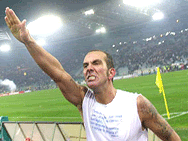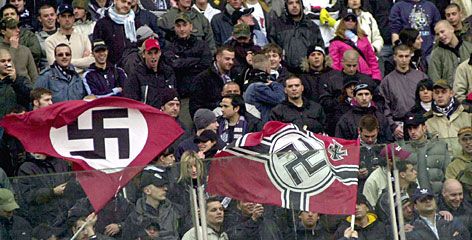Race Lines Are Bold in Sports
For most of us, a scenario in which a crowd at an NBA or NFL stadium directs an eruption of simulated monkey grunts at a black athlete is inconceivable. The notion that bananas could rain down from the stands of a Major League ballpark should seem bizarre and ridiculous. No functioning member of a modern society would hurl racial venom at a Michael Jordan or Jerry Rice, right? And if one were drunk enough or dense enough to do so, they’d surely be chastised or at minimum shunned by other, more socially conscious fans in the same section... wouldn’t they? Unfortunately, these acts have become commonplace crowd behavior in soccer stadiums throughout Europe and South America.
[Cameroon forward Samuel Eto'o threatens to leave the pitch in
reaction to racist chants.]
In a modern world, where sports are the new opium of the masses, basic societal views are revealed in the sports we worship. Leading up to the 2006 World Cup in Germany, ‘the beautiful game’ served as a showcase for the ugliest of human traits. Anti-racism organizations in the host nation warned non-white World Cup tourists not to visit rural towns on the outskirts of major cities like Berlin and Munich, for fear of increased racial crimes. Banners with Anti-racism messages hung from Olympic Stadium in Berlin, where in 1936, African-American sprinter Jesse Owens won four Gold Medals while Hitler watched. Like the country in which it stands, the stadium saw major renovations before hosting the tournament’s championship match between Italy and France. Yet, a look into the two finalists’ respective leagues reveals the truth about racism in soccer.
Bigotry abounds in Italy’s Serie A. While the problem of racism is nothing new to Italian soccer, the globalization of the sport has seen an influx of more African players in the peninsula. In Milan - far from the formerly communist German farm villages that so worried activists at the World Cup - Ivory Coast defender Marc Zoro was reduced to tears after enduring a barrage of racial epithets from local fans. Lost in the hypocritical prejudice of the Milan supporters was the reality that two of Inter Milan’s biggest and most celebrated stars, Adriano and Obafemi Martins, are men of color.

In the 66th minute of the match, a tearful Marc Zoro picked up the ball and proceeded to walk off the field. After pleading with the fans, Adriano and Martins managed to convince Zoro to continue playing. The Zoro case generated headlines around the world, but is still far from being an isolated case in Italy. On the contrary, Rome’s Stadio Olimpico is infamous for its right-winged fanatics, who hoist banners with swastikas and other fascist symbols and sometimes celebrate goals with Nazi salutes.

With the sheer number of talented black stars in French soccer, France ought to be a blueprint of multiracial harmony in sports. Unlike the Italian national team, which is made up exclusively of white players, the French national team draws heavily from its former African colonies. Les Bleus, as the national team is called, counts on players from Algeria, Cameroon, Senegal, Congo and Benin, among other countries. When riots broke out throughout the immigrant-filled suburbs in 2005, racial tensions in France rose to new levels. The beer-fueled bleachers of Stadiums such as Parc de Princes in Paris became a battle ground for racist soccer hooligans, who instead of brawling with supporters of rival clubs, were fighting fans of their own club who had different skin tones. As senseless as hooligan violence is, it becomes all the more baffling when supporters of the same club become divided among racial lines. In Parc de Princes, this line splits the stands into directly opposing sections. The “Kop of Boulogne,” which stands behind one of the goals, is almost entirely white. Across the field, behind the other goal, is the multi-cultural “Tribune d'Auteuil.” This segregation of the stands only avoids conflicts between the two sides during the 90 minutes of play. With little to no security outside the stadium, countless acts of racially motivated violence occur before and after the games.

This summer, over a billion TV sets were tuned in on Germany and the World Cup from June to early July. People of every sex, color and creed filled the Stadiums of the 12 designated world cup sites and even more took to the streets to watch the games on giant screens in designated “Fan Zones.” Before every match, a “football against racism” logo covered the center circle of every stadium, mirroring the multicultural unity exhibited throughout the tournament itself. Yet, much like the games in Paris’s Parc de Princes, the before and after the opening and final whistle tell a different story. Across South American and Europe, racial violence is still an ugly stain on the beautiful game. Racist fans still hurl banana peels, peanuts and insults at black players. So long as there is racism in our cultures, there will be racism in our sport.


1 Comments:
I am Colombian I know exactly what you mean.
Humans are competitive species always in search of the strongest and brightest.
The crowds are merciless, because alcohol mixes with group behavior that implies a level of acceptance.
Post a Comment
<< Home